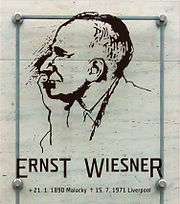Ernst Wiesner
Ernst Wiesner, also known as Arnošt Wiesner (21 January 1890, in Malacky, Kingdom of Hungary, Austro-Hungarian Empire – 15 July 1971, in Liverpool) was a modernist architect, one of the foremost interwar period architects of Brno. His ancestors with German surnames Wiesner actually came from Austrian which had migrated to Malacky before the unification of the two Kingdoms.

During 1908 to 1913 Wiesner studied at the Technical College and the Academy of Arts (taught by B. Ohmann) in Vienna. After the World War I he worked as an independent architect in the city of Brno, until 1939. Wiesner was a very active architect in the city between the World Wars. His work was greatly influenced by Adolf Loos and his pure constructions with their classicized balance and monumentality are amongst the best works to be constructed in Brno at that time.
Afterwards Wiesner emigrated to Great Britain where he joins the foreign anti-fascist resistance. After World War II he stayed in England. During 1948-50 he acted as a lecturer in the School of Architecture at the University of Oxford and during 1950-60 at the University of Liverpool. In 1969 he was nominated to the rank of honorary doctor by the University of Jan Evangelista Purkyně (now Masaryk University) in Brno. When he died in 1971 he was buried in Liverpool's Allerton Cemetery.

Architectural works in Brno
- Gutmannův dům (Gutmann's house) 1919–22[1]
- Moravská zemská životní pojišťovna (Moravian Provincial Life Insurance Company) 1920–1923
- Česká banka Union (Czech Union Bank; later seat of local branch of the Czechoslovak Broadcast) 1923–26
- Krematorium (Crematorium) 1926–29[2]
- Palác Morava (Palace Moravia) 1927–29. Completely finished in 1936
- Rodinný dvojdům (Double-family house) 1928
- Moravská banka (Moravian Bank) 1929–30, co-author Bohuslav Fuchs
- Činžovní dům Freundschaft (The Freundschaft ["Friendship"] tenement house) 1930–31
- Various family houses, industrial and manufacturing buildings around the City of Brno
References
Sources
- Riedl, Dušan (1992). Brněnská architektura 20. století (in Czech). Brno: Památkový ústav Brno. Úřad města Brna. ISBN 80-85032-14-7.
| Wikimedia Commons has media related to Ernst Wiesner. |
- Ernst Wiesner 1890 - 1971, Obecní dům Brno 2005, ISBN 8023956132
- http://www.bam.brno.cz/en/architect/32-ernst-wiesner?filter=code